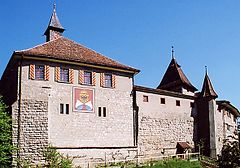Kyburg (castle)
| Kyburg | |
|---|---|

Schloss Kyburg
|
|
|
Location within Switzerland
|
|
| General information | |
| Classification | Swiss heritage site of national significance |
| Town or city | 8314 Kyburg |
| Country | Switzerland |
| Coordinates | 47°27′31″N 8°44′37″E / 47.4585°N 8.7435°E |
| Construction started | c. 1030 |
| Completed | c. 1530 |
| Website | |
| www.schlosskyburg.ch | |
Coordinates: 47°27′31″N 8°44′37″E / 47.4585°N 8.7435°E
Kyburg Castle (German: Schloss Kyburg) is a castle in Switzerland, overlooking the Töss river some 3 km south-east of Winterthur, in Kyburg municipality, canton of Zürich. It is a Swiss heritage site of national significance.
The first fortification at this site was likely built in the second half of the 10th century by the counts of Winterthur. It is first mentioned in 1027 under the name of Chuigeburg ("cows-fort"), which name points to an original use as a refuge castle for livestock. The modern spelling Kyburg first occurs in the 1230s (other spellings of the 11th to 13th century include Chiuburch, Cogiburk, Kuiburc, Chuͦweburg, Chyburc, Qwiburg, Kiburc, Chiburg, Kibor, Kyburc, Kiburg)
The early castle was destroyed in 1028 or 1030 by emperor Conrad II. A county of Kyburg was formed in 1053 as a possession of the counts of Dillingen, and from 1080, the counts of Kyburg emerged as a cadet line of the Dillingen family. They rose to be the most important noble family in the Swiss plateau beside the Habsburg and the House of Savoy by the 13th century. After the death of the last count in 1264 Rudolph of Habsburg claimed the inheritance for his family. With one interruption the Imperial Regalia of the Holy Roman Empire were kept in the castle between 1273 and 1322.
...
Wikipedia

